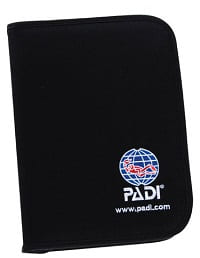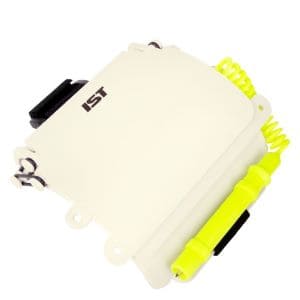Home › Scuba Diving › Equipment › Accessories › Log Books
Log Book and Underwater Slates
Having a diver's log book is a handy way of recording, and storing, information about diving experiences, including maximum depths and points of interest.
This guide explains why scuba divers should log the dives, what options they have for logging them (e.g. paper vs. digital apps), and the benefits of using a plastic writing slate.
Log Books for Keeping Records of the Dives
Logging the dive is one of the basic training fundamentals for all scuba diving levels.
Even so, the merits of keeping a dive log has been a source of debate.
Here's the thing:
The process of logging dives (recording data for future reference) is a simple one.
In addition, it is a mandatory requirement for students to perform after completing open water training dives.
The instructor who will qualify them needs to sign the log entries. Following that, some divers see the dive logging process as being a meaningless exercise - or completely unnecessary.
Pro Tip: Attach small photos of dive buddies to the relevant pages in your scuba log book so you'll be able to take a trip down 'memory lane' in later years.
Why Divers Should Be Logging the Dives
There are good and bad habits in scuba diving, and continuing to log dives is a commendable trait. Here are some important reasons to keep a record of your progress.
A Diver's Log is a Journal
Of course, the main reason for using log books is to store key diving data. But, it can also be a useful resource as a dive journal.
For example:
- To begin with, your log book entries should always contain the important information about the actual dive or training that you completed, including:
- Date and dive site location
- Water type (fresh or salt)
- Equipment configuration (e.g. sizes, weights)
- Time in and time out
- Bottom time and maximum depth
- Gas consumption (air in and air out) and gas mix (e.g. EANx)
- Water temperature
- Underwater visibility
- Time spent on safety stop
- Some divers use them to record milestones of where and when they made their 50th dive, or 100th. Plus, others might enjoy looking back at physical recordings of outstanding marine-life sightings.
- Scuba diving is a social sport right? So, don't underestimate the power of logging new names and contacts from your dive group. It can also be a personalised diary or scuba news journal where you can archive your own comments with extra thoughts about your ability and comfort level.
Providing Proof of Diving Experience
According to professionals, the most important reason to keep an up-to-date scuba log book is being able to show previous diving experience and frequency.
In fact, it's common for dive center owners or tour operators to place some experience-level restrictions, especially on liveaboard trips.
So, liveaboard operators may want to see some proof of experience (e.g. at least 50 logged dives). Whereas, dive instructors will use the data recorded in your training log to help them choose suitable diving destinations or when setting up your equipment.
Note: Are you planning on pursuing a career in diving? If so, to enrol in divemaster training you will need to show evidence of at least forty (40) logged dives.
Paper vs. Dive Log Apps
Thanks to modern technology, writing out dive logs with a pen and paper, and counting dive numbers, is becoming a thing of the past. Nowadays, you can also download data from many of the best dive computers using Bluetooth or cable.
Hence, in the interest of developing a paperless future, here are some innovative examples of different ways that divers can log their dives.
PADI Logbooks, Binders, and Digital Apps
Logbook Binders
Having three (3) punch-holes means divers can store their training logbooks inside the PADI Adventure Log Nylon Fabric Binder (Item Number: 79136).
Plus, the front and back spaces are handy for storing certification cards and the Recreational Dive Planner (RDP). Other useful diving records include:
 Adventure Log Refill Pages: Item Number 70036
Adventure Log Refill Pages: Item Number 70036- Divers Logbook Pages and card Holders with Red Cover (Training Record not included): Item Number 70048
- PADI Professional Training Log: Item Number 70137
- Revised - Divers Logbook (includes Training Record): Item Number 70047
Electronic Certification Cards (eCards)
One of the simplest ways to log dives is to use the electronic certification card (eCard) facility on a mobile device. This is a quick and easy way for PADI Dive Center owners and instructors to verify the data.
Because the PADI App™ stores data about eCards, there's no need to worry about losing the information. It also means you don't need to carry the plastic cards on any impromptu diving trips.
PADI® issues a free eCard to all successful Open Water Diver students (for 30 days). The pro-level eCards will be an inclusion of membership renewal.
Pro Tip: Check out the PADI Certification Cards FAQ section for answers to the popular questions asked by newly certified divers.
Digital Logbooks
Tech savvy divers can log training and recreational dives 'digitally' after downloading either of the two PADI Scuba Diving Apps or via their PADI ScubaEarth account.
Scubapro Water Proof Paper Log Book
The special waterproof paper allows divers to record dive data with wet hands or in soggy weather. Other unique features and specifications include:
- Recording data in categories, such as dive time, maximum depth, water hours to date, underwater visibility, air used, and water temperature.
- Weight: 0.25 pounds (1.59 ounces).
- The option to log up to fifty (50) dives on waterproof pages (including the one-year warranty).
Note: The main section contains a list of all the best scuba diving accessories available online from major retail stores.
DiveMate (Scuba Dive Log)
This unique diving logbook is great for scuba divers who want to keep their diving memories. You can store underwater maps, photographs, dive buddy contact info, and other personal notes.
You won't need a notebook after downloading DiveMate for Android. You can use the direct connection to dive computers, smartphones, or tablets.
Pro Tip: DiveMate is available in Google Play Store and the supported languages include English, German, Dutch, French, Italian, Spanish, and Russian.
WR3-F Glow-in-the-Dark Underwater Writing Slate
The multi-side underwater writing slate made by IST Sports is ideal for scuba teachers as well as for recreational divers.
We often get asked 'can you talk while scuba diving'. Well, this is one of the clearest methods that some instructors use for communicating safety instructions with students underwater.
Furthermore, the WR3-F Underwater Writing Slate glows in the dark (ideal for the PADI Night Diver course or for diving in low-visibility).
Key Features
 The unique slate with elastic hinge bands creates extra writing space without losing its compactness
The unique slate with elastic hinge bands creates extra writing space without losing its compactness- Dimensions: 4.1 x 4.7 inches (10.5 x 12 centimetres)
- Velcro™ strap attaches to a diver's forearm for optimum streamlining with high-visibility Neon Yellow
- Having a charcoal pencil helps to prevent corrosion (attached with stretchy plastic coil and handy storage facility in the integrated sleeve)
- 3 snap open layers with 5 writing surfaces with large side tabs is great for easy opening and closing (even when you're wearing neoprene dive gloves)
Note: The scuba equipment section contains more information about the gear divers use with some extra safety tips for beginners.
Related Information and Help Guides
- Cool Diving Gadgets and Scuba Stuff Reviews
- Diving Flags and Floats Explained for Beginners
- List of Surface Signalling Devices for Scuba
Pro Tip: The short video tutorial presented by Scuba Diver Magazine explains how to restart logging dives if you lost your log book. You can also "Ask a PADI Pro' if you have a question.